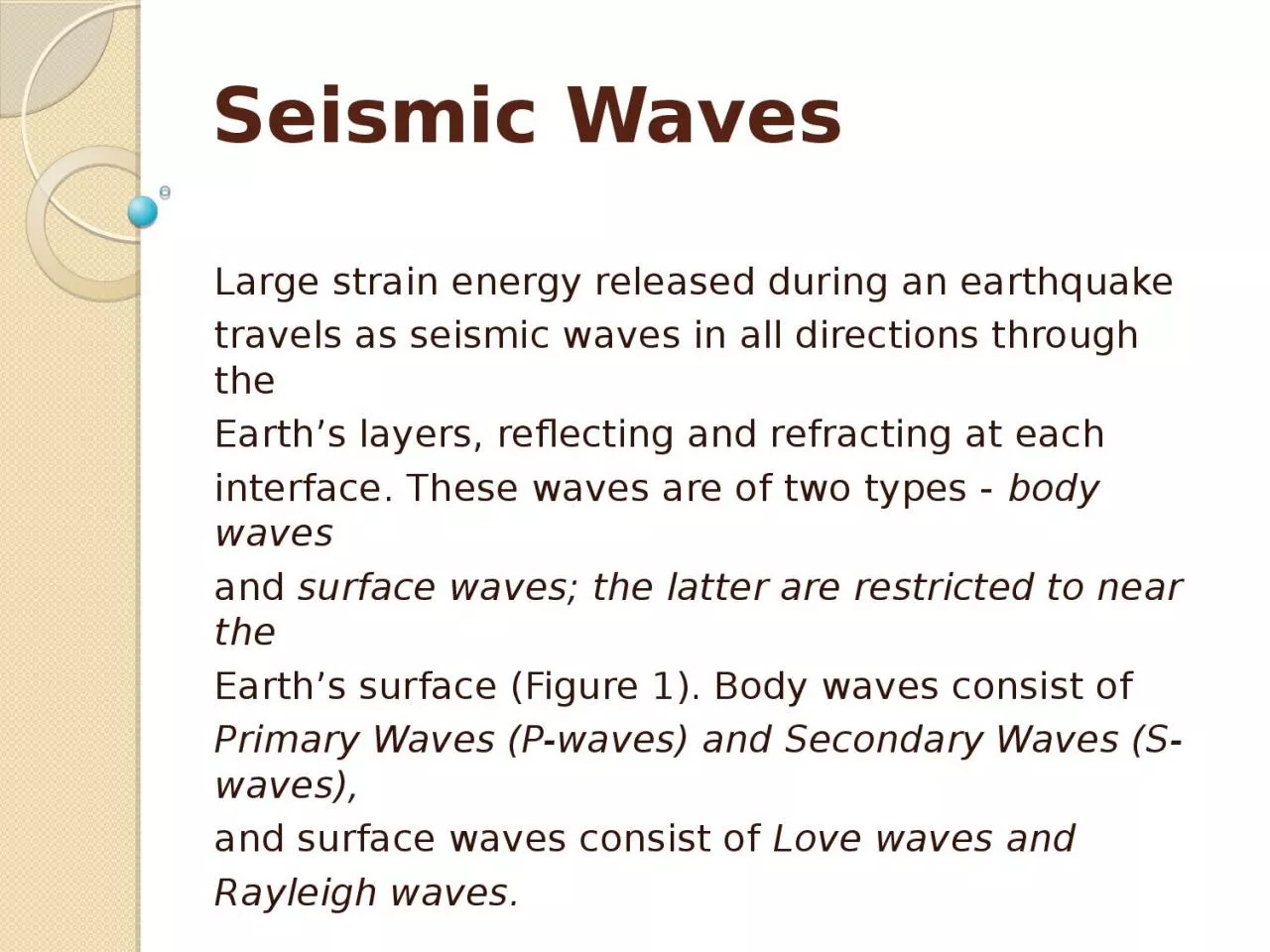

travels as seismic waves in all directions through the Earths layers reflecting and refracting at each interface These waves are of two types body waves and surface waves the latter are restricted to near the ID: 1024909
Download Presentation The PPT/PDF document "Seismic Waves Large strain energy releas..." is the property of its rightful owner. Permission is granted to download and print the materials on this web site for personal, non-commercial use only, and to display it on your personal computer provided you do not modify the materials and that you retain all copyright notices contained in the materials. By downloading content from our website, you accept the terms of this agreement.
1. Seismic WavesLarge strain energy released during an earthquaketravels as seismic waves in all directions through theEarth’s layers, reflecting and refracting at eachinterface. These waves are of two types - body wavesand surface waves; the latter are restricted to near theEarth’s surface (Figure 1). Body waves consist ofPrimary Waves (P-waves) and Secondary Waves (S-waves),and surface waves consist of Love waves andRayleigh waves.
2.
3.
4. P-waves are fastest, followed in sequence by S-, Love and Rayleigh waves. For example, in granites, P and S-waves have speeds ~4.8 km/sec and ~3.0km/sec, respectively. S-waves do not travel through liquids. S-waves in association with effects of Love waves cause maximum damage to structures by their racking motion on the surface in both vertical and horizontal directions.
5. When P- and S-waves reach the Earth's surface, most of their energy is reflected back. Some of this energy is returned back to the surface by reflections at different layers of soil and rock. Shaking is more severe (about twice as much) at the Earth's surface than at substantial depths.
6. MagnitudeMagnitude is a quantitative measure of the actual size of the earthquake.IntensityIntensity is a qualitative measure of the actual shaking at a location during an earthquake, and is assigned as Roman Capital Numerals.
7. Inertia Forces in StructuresEarthquake causes shaking of the ground. So a building resting on it will experience motion at its base. From Newton’s First Law of Motion, even though the base of the building moves with the ground, the roof has a tendency to stay in its original position. But since the walls and columns are connected to it, they drag the roof along with them.
8.
9. The Earthquake ProblemSeverity of ground shaking at a given location during an earthquake can be minor, moderate and strong. Relatively speaking, minor shaking occurs frequently, moderate shaking occasionally and strong shaking rarely. For instance, on average annually about 800 earthquakes of magnitude 5.0-5.9 occur in the world while the number is only about 18 for magnitude range 7.0-7.9
10.
11. Earthquake Design PhilosophyThe earthquake design philosophy may be summarized as follows :(a) Under minor but frequent shaking, the main members of the building that carry vertical and horizontal forces should not be damaged; however building parts that do not carry load may sustain repairable damage.
12. (b) Under moderate but occasional shaking, the main members may sustain repairable damage, while the other parts of the building may be damaged such that they may even have to be replaced after the earthquake; and(c) Under strong but rare shaking, the main members may sustain severe (even irreparable) damage, but the building should not collapse.
13. Importance of FlexibilityThe ground shaking during an earthquake contains a mixture of many sinusoidal waves of different frequencies, ranging from short to long periods .The time taken by the wave to complete one cycle of motion is called period of the earthquake wave. In general, earthquake shaking of the ground has waves whose periods vary in the range 0.03-33sec. Even within this range, some earthquake waves are stronger than the others.
14.
15. Importance of Seismic Design CodesAn earthquake-resistant building has four virtues in it, namely:(a) Good Structural Configuration: Its size, shape and structural system carrying loads are such that they ensure a direct and smooth flow of inertia forces to the ground.(b) Lateral Strength: The maximum lateral (horizontal) force that it can resist is such that the damage induced in it does not result in collapse.
16. (c) Adequate Stiffness: Its lateral load resisting system is such that the earthquake-induced deformations in it do not damage its contents under low-to moderate shaking.(d) Good Ductility: Its capacity to undergo large deformations under severe earthquake shaking even after yielding, is improved by favourable design and detailing strategies
17. Indian Seismic CodesIS 1893 (Part I), 2002, Indian Standard Criteria for Earthquake Resistant Design of Structures (5th Revision)IS 4326, 1993, Indian Standard Code of Practice for Earthquake Resistant Design and Construction of Buildings (2nd Revision)IS 13827, 1993, Indian Standard Guidelines for Improving Earthquake Resistance of Earthen BuildingsIS 13828, 1993, Indian Standard Guidelines for Improving Earthquake Resistance of Low Strength Masonry BuildingsIS 13920, 1993, Indian Standard Code of Practice for Ductile Detailing of Reinforced Concrete Structures Subjected to Seismic ForcesIS 13935, 1993, Indian Standard Guidelines for Repair and Seismic Strengthening of Buildings